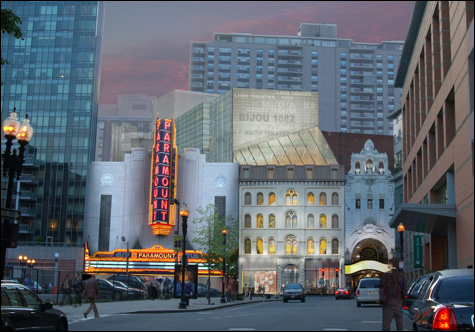
PROJECTING THE FUTURE: Emerson College’s Paramount Center Project, shown here in the architect’s rendering, will turn the Paramount and the Bijou into an innovative student center. |
Looking at the photographs now, it’s hard to believe it ever existed. But there it is: downtown Washington Street, aglow with the blinking of countless movie marquees, up and down the block and beyond, nearly every other door a theater or cinema.
Hollywood itself can trace its roots to this very neighborhood, with future-thinking founders of RKO and MGM operating round-the-clock vaudeville palaces, lit by Edison’s electric lights as the 19th century waned and flickering kinetoscopes as the 20th century dawned. This little stretch of asphalt is a crucible of American pop culture.
Mayor Thomas Menino has been instrumental in branding the Tremont Street/Washington Street neighborhood as the Theater District. Even so, three years ago he outraged many preservationists by seeing through the demolition of the century-old Gaiety Theatre to make room for a luxury high rise. Now, thanks to Emerson College’s Paramount Center project, which Menino also spearheaded, the mayor is paying proper and innovative tribute to the Theater District’s illustrious legacy of arts and entertainment.
It’s a massive undertaking, one that will benefit both Emerson and the city: a 145,000-square foot, $77 million restoration and repurposing of two moldering buildings that, when opened in fall of 2009, will contain a 500-seat concert hall, a black-box theater, a film-screening room, numerous rehearsal rooms, a scenery-making shop, a ground-floor restaurant, and housing for more than 250 students. When all is said and done, the complex at 543–547 Washington Street — the Paramount Theatre, and the so-called Levin Arcade Building next door (home to the old Boston Bijou Theatre) — will be given new life.
At the project’s groundbreaking ceremony, before taking a shovel and tossing aside a small clump of earth, Menino recalled watching movies at the Paramount as a boy. And he spoke of how the vacant building’s renovation represents a “new chapter in Boston’s cultural history.”
Hizzoner may wax nostalgic about matinees at the Paramount. And the theater’s mammoth 60-foot-tall, 3000-bulb marquee may be the most visually striking element on lower Washington Street. But it’s the old Bijou Theatre — smaller, simpler, and somewhat dismissively referred to as an “arcade” — that’s the true historic gem of this section of the Theater District. Its roots date back to Colonial times, and in its 19th-century heyday it was one of the most significant performing-arts spaces in the country.
Today, its interior is all but unsalvageable (unlike that of the Paramount, which is being restored to its post–Jazz Age grandeur), but its reopening is a welcome next step in the rejuvenation of the Theater District. As lower Washington Street looks to the future, the challenge of this project — and the fun of it — is deciding how to venerate two very different theaters’ illustrious pasts.
Porn, history, and Hollywood
Prior to its ignominious mid-’70s decline, when skin flicks lit its cavernous gloom and triple X’s spangled its marquee, the Paramount Theater was among the last Art Deco movie palaces in downtown Boston. Opened in 1932, the only theater in town devoted exclusively to motion pictures, it was a beaut: all stylized flowers and sunbursts, and complex geometric flourishes. Its elegance notwithstanding, though, the Paramount isn’t exactly rich with history.
The Bijou, on the other hand, has a long and illustrious pedigree. So Fred McLennan, 61, a theater historian who lives on Martha’s Vineyard, has made it his mission to ensure that history is preserved as much as possible as the Paramount project goes forward.
Even before it was a theater, McLennan says, the space where the Bijou stands was a significant spot. “When Boston only had 14,000 people in it, that stretch of Washington Street was comprised primarily of inns and taverns. And [the Bijou building] is sitting on two foundations, one of which might go back to 1711.”
In 1836, one of those ale houses, Lion Tavern, transmogrified into the Lion Theater, which was unique for its in-house equestrian stables. One of the first performances there, McLennan says, starred the legendary Junius Brutus Booth, father of famous 19th-century actor Edwin Booth — and infamous 19th-century assassin, John Wilkes Booth. In 1839, the Lion became a lecture hall, the Mechanics Institute, and changed later that year into the Handel and Haydn Society’s Melodeon, the principal concert hall in Boston. In 1878, the building — the present façade of which was erected in 1840s — was rechristened the Gaiety Theatre.
By 1882, it had taken on yet another identity: the Bijou Theatre, owned and operated by New Hampshire showman Benjamin Franklin Keith. It was here that Keith helped pioneer a style of variety theater that came to be known as vaudeville. Keith kept the Bijou packed around the clock with his unprecedented continuous variety shows running from morning until late night, every day of the week.